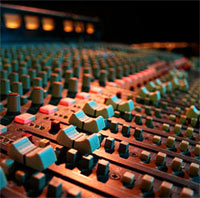 Though it might not sound like a logical connection, an increasing number of design firms are emphasizing audio production and engineering in web design products. The reason for this has everything to do with the viral nature of modern Internet usage and marketing: As services like YouTube and Vine grow in popularity for marketing, advertising, and personal services, website designs absolutely need to begin integrating better support for smooth, robust audio that sounds good on mobile devices and desktops alike. This is where audio production and engineering comes into play. As part of these skill sets, professionals know how to create robust acoustics in a “tight” space, whether that’s a small smartphone speaker or a music hall with bad inherent acoustics.
Though it might not sound like a logical connection, an increasing number of design firms are emphasizing audio production and engineering in web design products. The reason for this has everything to do with the viral nature of modern Internet usage and marketing: As services like YouTube and Vine grow in popularity for marketing, advertising, and personal services, website designs absolutely need to begin integrating better support for smooth, robust audio that sounds good on mobile devices and desktops alike. This is where audio production and engineering comes into play. As part of these skill sets, professionals know how to create robust acoustics in a “tight” space, whether that’s a small smartphone speaker or a music hall with bad inherent acoustics.
The Time Has Come for an Internet Dominated Rich Media
In the past several years, social networking has moved well beyond its Friendster, MySpace, and Facebook roots. Today, more users than ever are posting pictures to Instagram, taking short videos that get uploaded to Vine, and turning their written blog into a “vlog,” or video blog. This means that the best Internet experience involves smooth video and robust audio, and it means that designing for the web is no longer about HTML and CSS on their own. Indeed, most web design companies are now hiring rich media professionals that can specialize in professional video production, audio engineering, and audio integration into an existing web design. Engineers are primed to take on these positions and provide a few crucial services:
Selection of the Proper Codec
Audio production specialists are usually charged with finding the right codec for use in a mobile or desktop web design. This selection process involves choosing a codec that produces rich sound, makes voices and music files clear, and still compresses audio into a size that can be downloaded by mobile networks. Engineers need to choose compression styles and levels, codec technologies, and methods of integration, that work with the widest possible group of users and devices.
An Embrace of Portable Devices in Audio Integration
Another key task of today’s audio engineers is to figure out how a website can offer rich media that works for mobile devices. Because these devices come with very small speakers and little independent sound processing hardware, an improperly designed website might leverage the wrong codec and actually cause distorted audio to play when an end user engages the media. Audio engineers will know how to mix sounds so that they don’t sound distorted, overly “tinny,” or low quality, according to the Bureau of Labor Statistics.
Work Alongside Video Producers for a Great Overall Experience
Audio and video go hand in hand on today’s websites, which means audio engineers must work collaboratively with video producers to create a product that plays nicely on YouTube, looks and sounds great on a smartphone, and scales properly to a larger desktop screen with greater audio processing capabilities.
Related Resource: Visual Effects Jobs
A New Area of Professional Web Design Expertise is Beginning to Emerge
Web programming and HTML proficiency will likely always be required of modern design studios. Increasingly, however, audio and video production services are determining how websites interact with their users and how those users virally share the site’s content. For this reason, one of the fastest-growing segments of the web design industry is in audio production and engineering in web design.
 Follow
Follow
